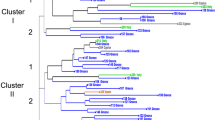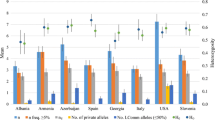Abstract
Common fig (Ficus carica L.) is one of the most ancient domesticated species, originated, supposedly in Arabia, from where it diffused to the Middle East and Asia, and to the Mediterranean basin, where it greatly diffused. More than 600 fig varieties have been described, but it is conceivable that this number is underestimated. Along all the Italian territory, there is a rich germplasm of fig composed of a large number of varieties (approximately 300) of very not well defined origin. Effectively, during several centuries of cultivation and propagation by seed, a large number of genotypes appeared and were selected, leading to the generation of an uncountable number of genotypes, different in numerous traits, particularly in those related to leaves and fruits features. Unfortunately, the extensive existing fig genetic patrimony is facing genetic erosion; for this reason, it is extremely important to study and valorised it, in order to preserve the remaining biodiversity. The purpose of this study was to genetically characterize, with nSSR markers, 79 fig accessions, collected in several areas in Italy. The set of chosen markers resulted highly polymorphic, and allowed the characterization of all the studied accessions. Data were analysed by cluster analysis, and the results demonstrated a great genetic variability within the population. The nSSR used, moreover, allowed us to identify all accessions and to recognised possible homonyms and synonyms, and cases of intravarietal clones.

Similar content being viewed by others
References
Abou-Ellail M, Mahfouze SA, El-Enay MAM, Mustafa NSA (2014) Using biochemical and simple sequence repeats (SSR) markers to characterize (Ficus carica L.) cultivars. World Appl Sci J 29(3):313–321. https://doi.org/10.5829/idosi.wasj.2014.29.03.13835
Achtak H, Oukabli A, Ater M, Santoni S, Kjellberg F, Khadari B (2009) Microsatellite markers as reliable tools for fig cultivar identification. J Am Soc Hortic Sci 134(6):624–631. https://doi.org/10.1007/s10681-010-0286-9
Aradhya MK, Stover E, Velasco D, Koehmstedt A (2010) Genetic structure and differentiation in cultivated fig (Ficus carica L.). Genetica 138:681–694. https://doi.org/10.1007/s10709-010-9442-3
Baldini E (1953) Alcuni aspetti della coltura del fico nella provincia di Firenze. Riv Ortoflorfrutt Ital 7–8:185–203
Baraket G, Chatti K, Saddoud O, Abdelkarim AB, Mars M, Trifi M, Hannachi AS (2011) Comparative assessment of SSR and AFLP markers for evaluation of genetic diversity and conservation of fig, Ficus carica L., genetic resources in Tunisia. Plant Mol Biol Rep 29(1):171–184. https://doi.org/10.1007/s11105-010-0217-x
Barberis A, Chessa I, Nieddu G (2001) Analisi multivariata dei descrittori primari del germoplasma di fico della Sardegna. Italus Hortus 8(5):12–15
Basso M (1960a) Contributo allo studio della coltura del fico nella provincia di Pisa. Riv Ortoflorfrutt Ital 3–4:1–17
Basso M (1960b) Contributo allo studio della coltura del fico nella provincia di Livorno. Riv Ortoflorfrutt Ital 5–6:194–208
Beghé D, Ganino T, Dall’Asta C, Silvanini A, Cirlini M, Fabbri A (2013) Identification and characterization of ancient Italian chestnut using nuclear microsatellite markers. Sci Hortic 164:50–57. https://doi.org/10.1016/j.scienta.2013.09.009
Brookfield JFY (1996) A simple new method for estimating null allele frequency from heterozygote deficiency. Molecular Ecology 5(3):453-455. https://doi.org/10.1046/j.1365-294X.1996.00098x
Brown AHD, Weir BS (1983) Measuring genetic variability in plant populations. In: Tanksley SD, Orton PA (eds) Isozymes in plant genetics and breeding. Elsevier Science Publications, Amsterdam
Buonincontri M, Moser D, Allevato E, Basile B, Di Pasquale G (2014) Farming in a rural settlement in central Italy: cultural and environmental implications of crop production through the transition from Lombard to Frankish influence (8th–11th centuries A.D.). Veg Hist Archaeobot 23:775–788. https://doi.org/10.1007/s00334-013-0429-8
Cabrita LF, Aksoy U, Hepaksoy S, Leitão JM (2001) Suitability of isozyme, RAPD and AFLP markers to assess genetic differences and relatedness among fig (Ficus carica L.) clones. Sci Hortic 87:261–273. https://doi.org/10.1016/S0304-4238(00)00181-3
Çalişkan O, Polat AA (2012) Morphological diversity among fig (Ficus carica L.) accessions sampled from the Eastern Mediterranean Region of Turkey. Turk J Agric For 36:179–193. https://doi.org/10.3906/tar-1102-33
Chessa I, Erre P, Nieddu M, Satta D, Nieddu G (2001) Applicazione di marcatori molecolari RAPD in una collezione di germoplasma sardo di fico (Ficus carica L.). Italus Hortus 8(5):16–19
Ciarmiello LF, Piccirillo P, Carillo P, De Luca A, Woodrow P (2015) Determination of the genetic relatedness of fig (Ficus carica L.) accessions using RAPD fingerprint and their agro-morphological characterization. S Afr J Bot 97:40–47. https://doi.org/10.1016/j.sajb.2014.11.012
Cipriani G, Marrazzo MT, Marconi R, Cimato A, Testolin R (2002) Microsatellite markers isolated in olive (Olea europaea L.) are suitable for individual fingerprinting and reveal polymorphism within ancient cultivars. Theor Appl Genet 104(2–3):223–228. https://doi.org/10.1007/s001220100685
Condit IJ (1955) Fig varieties: a monograph. Calif Agric 23(11):323–538
De Masi L, Cipollaro M, Di Bernardo G, Galderisi U, Galano G, Pavone E, Grassi G, Simeone A, Cascino A (2003) Clonal selection and molecular characterization by RAPD analysis of the fig (Ficus carica L.) “Dottato” and “Bianco del Cilento” cultivars in Italy. Acta Hortic 605:65–68
do Val ADB, Souza CS, Ferreira EA, Salgado SML, Pasqual M, Cançado GMA (2013) Evaluation of genetic diversity in fig accessions by using microsatellite markers. Genet Mol Res 12(2):1383–1391. https://doi.org/10.4238/2013.April.25.9
Doyle JJ, Doyle JL (1987) A rapid DNA isolation procedure for small quantities of fresh leaf tissue. Phytochem Bull 19:11–15
Ercisli S, Tosun M, Karlidag H, Dzubur A, Hadziabulic S, Aliman Y (2012) Color and antioxidant characteristics of some fresh fig (Ficus carica L.) genotypes from Northeastern Turkey. Plant Foods Hum Nutr 67:271–276. https://doi.org/10.1007/s11130-012-0292-2
Essid A, Aljane F, Ferchichi A, Hormaza JI (2015) Analysis of genetic diversity of Tunisian caprifig (Ficus carica L.) accessions using simple sequence repeat (SSR) markers. Hereditas 152:1. https://doi.org/10.1186/s41065-015-0002-9
Falistocco E (2009) Presence of triploid cytotypes in the common fig (Ficus carica L.). Genome 52:919–925. https://doi.org/10.1139/g09-068
Ferrara G, Mazzeo A, Pacucci C, Mataresse AMS, Tarantino A, Crisosto C, Incerti O, Marcotuli I, Nigro D, Blanco A, Gadaleta A (2016) Characterization of edible fig germplasm from Puglia, southeastern Italy: is the distinction of three fig types (Smyrna, San Pedro and Common) still valid? Sci Hortic 205:52–58. https://doi.org/10.1016/j.scienta.2016.04.016
Gaaliche B, Saddoud O, Mars M (2012) Morphological and pomological diversity of fig (Ficus carica L.) cultivars in Northwest of Tunisia. ISRN Agron 2012, Article ID 326461. https://doi.org/10.5402/2012/326461
Giraldo E, López-Corrales M (2008) Optimization of the management of an ex situ germplasm bank in common fig with SSRs. J Am Soc Hortic Sci 133(1):69–77
Giraldo E, Viruel MA, Lòpez-Corrales M, Hormaza JI (2005) Characterisation and cross-species transferability of microsatellites in the common fig (Ficus carica L.). J Hortic Sci Biotechnol 80:217–224. https://doi.org/10.1080/14620316.2005.11511920
Giraldo E, López-Corrales M, Roger JP, Khadari B, Hochu I, Santoni S, Hormaza JI (2008) Standardization of experimental protocols and SSR markers for the management of fig germplasm collections. Acta Hortic (ISHS) 798:213–216. https://doi.org/10.17660/ActaHortic.2008.798.29
Giraldo E, López-Corrales M, Hormaza JI (2010) Selection of the most discriminating morphological qualitative variables for characterization of fig germplasm. J Am Soc Hortic Sci 135(3):240–249
Grassi G (1998) Studies of Italian fig germplasm. Acta Hortic (ISHS) 480:97–102
Hocquigny S, Pelsy F, Dumas V, Kindt S, Heloir MC, Merdinoglu D (2004) Diversification within grapevine cultivars goes through chimeric states. Genome 47(3):579–589. https://doi.org/10.1139/g04-006
Jakše J, Satovic Z, Javornik B (2004) Microsatellite variability among wild and cultivated hops (Humulus lupulus L.). Genome 47:889–899. https://doi.org/10.1139/g04-054
Khadari B (2012) Ex situ management of fig (Ficus carica L.) genetic resources: towards the establishment of the Mediterranean reference collection. Acta Hortic (ISHS) 940:67–74. http://www.actahort.org/books/940/940_7.htm
Khadari B, Lashermes P, Kjellberg F (1995) RAPD fingerprints for identification and genetic characterization of fig (Ficus cairica L.) genotypes. J Genet Breed 49:77–86
Khadari B, Hochu I, Santoni S, Kjellberg F (2001) Identification and characterisation of microsatellite loci in the common fig (Ficus carica L.) and representative species of genus Ficus. Mol Ecol Notes 1:191–193. https://doi.org/10.1046/j.1471-8278.2001.00072.x
Khadari B, Hochu I, Bouzid L, Roger JP, Kjellberg F (2003) The use of microsatellite markers for identification and genetic diversity evaluation of fig collection in CBNMP. Acta Hortic 605:77–86
Khadari B, Grout C, Santoni S, Kjellberg F (2005) Contrasted genetic diversity and differentiation among Mediterranean populations of Ficus carica L.: a study using mtDNA RFLP. Genet Resour Crop Evol 52:97–109. https://doi.org/10.1007/s10722-005-0290-4
Kirby LT (1990) DNA fingerprinting. An introduction. Stockton Press, New York
Knap T, Jakše J, Cregeen S, Javornik B, Hladnik M, Bandelj D (2016) Characterization and defining of a core set of novel microsatellite markers for use in genotyping and diversity study of Adriatic fig (Ficus carica L.) germplasm. Braz J Bot 39(4):1095–1102. https://doi.org/10.1007/s40415-016-0299-2
Laddomada B, Gerardi C, Mita G, Lumare D, Minonne F, Marchiori S, Fiocchetti F (2008) Molecular characterization of Apulian fig (Ficus carica L.) germplasm collection using fluorescence-based AFLP markers. Acta Hortic 798:205–212
Mariotti Lippi M, Bellini C, Mori Secci M, Gonnelli T (2009) Comparing seeds/fruits and pollen from a Middle Bronze age pit in Florence (Italy). J Archaeol Sci 36(5):1135–1141. https://doi.org/10.1016/j.jas.2008.12.017
Mariotti Lippi M, Bellini C, Mori Secci M, Gonnelli T, Pallecchi P (2015) Archaeobotany in Florence (Italy): landscape and urban development from the late Roman to the Middle Ages. Plant Biosyst 149(1):216–227. https://doi.org/10.1080/11263504.2013.822433
Mawa S, Husain K, Jantan I (2013). Ficus carica L. (Moraceae): phytochemistry, traditional uses and biological activities. Evid Based Complement Altern Med, Article ID 974256. https://doi.org/10.1155/2013/974256
Minonne F, Ippolito I, Marchiori S (2001) L’attività dell’orto botanico di Lecce nel reperimento e la propagazione delle vecchie cultivar di Ficus carica L. Italus Hortus 8(5):30–33
Paetkau D, Calvert W, Stirling I, Stroberck C (1995) Microsatellite analysis of population structure in Canadian polar bears. Mol Ecol 4:347–354. https://doi.org/10.1111/j.1365-294X.1995.tb00227.x
Papadopoulou K, Ehaliotis C, Tourna M, Kastanis P, Karydis I, Zervakis G (2002) Genetic relatedness among dioecious Ficus carica L. cultivars by random amplified polymorphic DNA analysis, and evaluation of agronomic and morphological characters. Genetica 114:183–194. https://doi.org/10.1023/A:1015126319534
R Development Core Team (2005) R: a language and environment for statistical computing. R Foundation for Statistical Computing, Vienna. http://www.R-project.org
Rattighieri E, Rinaldi R, Bowes K, Mercuri AM (2013) Land use from seasonal archaeological sites: the archaeobotanical evidence of small Roman farmhouses in Cinigiano, South-Eastern Tuscany-Central Italy. Ann Bot 3:207–215. https://doi.org/10.4462/annbotrm-10267
Saddoud O, Chatti K, Salhi-Hannachi A, Mars M, Rhouma A, Marrakchi M, Trifi M (2007) Genetic diversity of Tunisian figs (Ficus carica L.) as revealed by nuclear microsatellites. Hereditas 144(4):149–157. https://doi.org/10.1111/j.2007.0018-0661.01967.x
Saddoud O, Baraket G, Chatti K, Trifi M (2011) Using morphological characters and simple sequence repeat (SSR) markers to characterize tunisian fig (Ficus carica L.) cultivars. Acta Biol Crac 53:7–14. https://doi.org/10.2478/v10182-011-0019-y
Storey WB (1976) Fig Ficus carica (Moraceae). In: Simmonds NW (ed) Evolution of crop plants, 2nd edn. Wiley-Blackwell, London, pp 205–208
Turfa JM (2012) Background on agriculture, agronomy in prehistoric Italy. In: Turfa JM (ed) Divining the etruscan world: the brontoscopic calendar and religious practice. Cambridge University Press, Cambridge, pp 152–153
UPOV (2010) Guidelines for the conduct of tests for distinctness, homogeneity and stability, fig edn. International union for the protection of new varieties of plants, Genéve
Veberic R, Mikulic-Petkovsek M (2016) Phytochemical composition of common fig (Ficus carica L.) cultivars. In: Simmons MSJ, Preedy VR (eds) Nutritional composition of fruit cultivars. Elsevier, Amsterdam, pp 235–255
Wagner HW, Sefc KM (1999) Identity 1.0: freeware program for the analysis of microsatellite data. Vienna. http://www.boku.ac.at/zag/forsch/identity.htm
Author information
Authors and Affiliations
Corresponding author
Ethics declarations
Conflict of interest
The authors declare that they have no conflict of interest.
Electronic supplementary material
Below is the link to the electronic supplementary material.
Rights and permissions
About this article
Cite this article
Rodolfi, M., Ganino, T., Chiancone, B. et al. Identification and characterization of Italian common figs (Ficus carica) using nuclear microsatellite markers. Genet Resour Crop Evol 65, 1337–1348 (2018). https://doi.org/10.1007/s10722-018-0617-6
Received:
Accepted:
Published:
Issue Date:
DOI: https://doi.org/10.1007/s10722-018-0617-6




